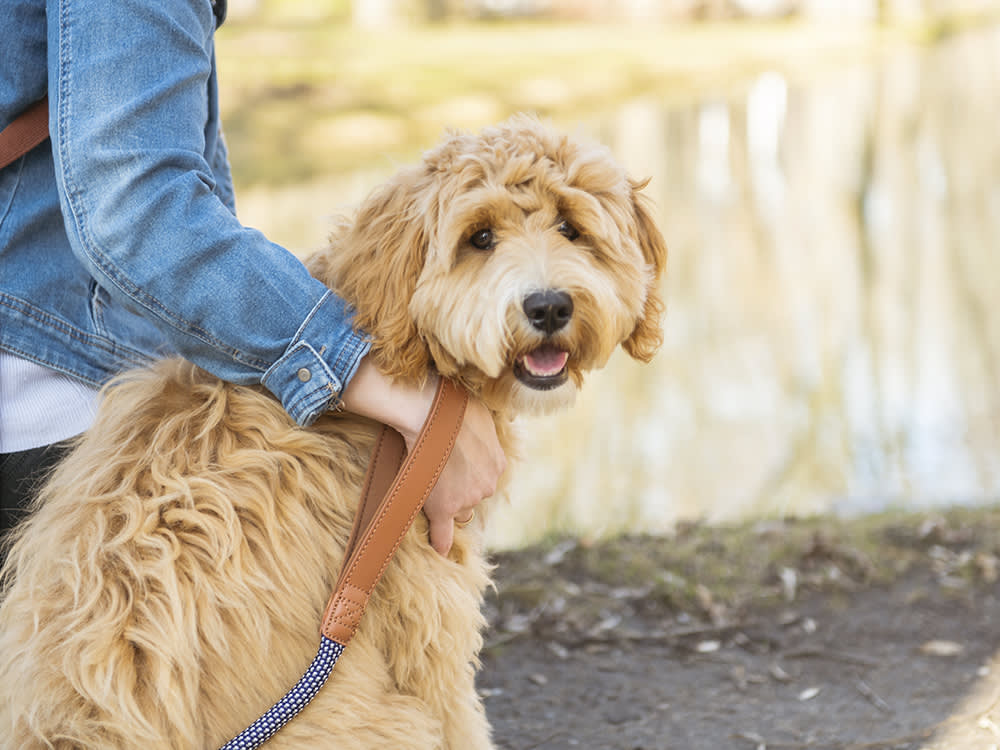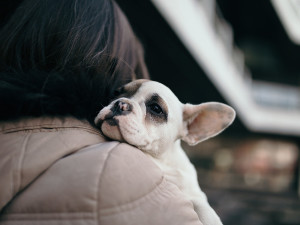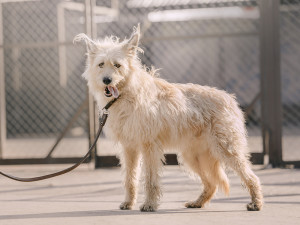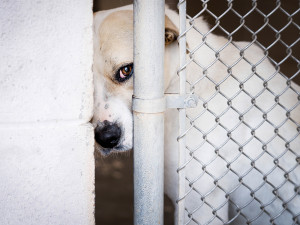From Goldendoodles to Puggles — the Truth About “Designer Dogs”
Do your research. Know the facts.

share article

Your pet wants you to read our newsletter. (Then give them a treat.)
Goldendoodle. Puggle. Cockapoo. Pomsky. These are all words that, in recent years, we’ve come to accept as part of modern dog-breed vernacular. At one time, these combined sounds would have just been gibberish to the common dog parent.
These days, it seems as if the list of these “designer dogs” grows every year. These dogs seemingly combine the best features of two different breeds — for example, a Puggleopens in a new tab (a cross between a Pug and Beagle) provides the fun energy of a Beagleopens in a new tab and the cuddliness of a Pug.
In 2019, the creator of the Labradoodle said he regrets creating the breed (he said he “opened a Pandora’s box and released a Frankenstein’s monster”). This begs the questions: Are designer dogs a bad idea? Are designer dog breeders more concerned with making money than creating a healthy pup?
To help break the issue down for us, we talked to Dr. Bruce Smith, VMD, PhDopens in a new tab, a scientist and professor of pathobiology at Auburn University’s College of Veterinary Medicine. Here, he explains what exactly a designer dog is and whether it’s a good idea to get one.
What are designer dogs?
People use the term “designer dogs” to refer to new mixes of breeds, but I think that is a misnomer. Technically, all domestic dogs are “designer dogs.” The domestic dog may be the first genetically modified organism (GMO) created by humans. Ever since a few wolves with gene variants that made them more curious or less fearful of humans started hanging around the campfires of our ancestors, we have been manipulating the genetics of dogs.
Over the past 20,000 or so years, we humans have intentionally bred dogs by selecting parents with desirable traits, then deciding which of their offspring best matched our needs (hunting, herding, hauling, etc.). Interestingly, most modern dog breeds have been derived within the past 300 to 400 years. Many of those were created by cross-breeding two or more early breeds to give some new, desirable combination of characteristics.
The Labradoodle, the dog that started the current “designer dog” phenomenon, is no different. Wally Coonronopens in a new tab, originator of the breed, was looking for the personality of a Labrador Retriever combined with the hypoallergenic coat of a Poodle. He had a specific need, and just like everyone who preceded him, he selected parents based on the traits he wanted to see in the offspring.
Many other individuals, seeing a market for interesting combinations and a potential for profit, started making all kinds of crosses, many with no real focused need. That focused need is important, because it drives selection of only those dogs that actually have the desired trait. In reality, that’s not as simple as just breeding a Labrador Retriever to a Poodle and training their puppies to guide the blind. In fact, the genetics of these crosses even raise some very serious questions about the suitability of these dogs for their intended purposes.
What happens genetically when a dog is bred to a closely related dog?
Dog breeds become breeds by continued breeding of dogs in a line from a limited group of founders. Mating closely related dogs can create many genetic problems. The reason for this is that most genes that cause problems are recessive. By mating relatives, the chance increases that the offspring receives two copies of the recessive gene, and we commonly see increased rates of genetic disease in matings of close relatives.
Unfortunately, those diseases are one of two major sources of genetic problems that can be seen with designer dogs. In this case, with very few original dogs, it may be necessary to mate relatively closely related dogs to expand the “breed.” This is not just a problem for these “fad” designer dogs — but also for relatively rare breed of dogs.
The second source of genetic problems with designer dogs are the unscrupulous people who simply make these dogs for financial gain, without regard to the background of the dogs that they are using or to the quality of the puppies that they produce. A Labradoodle that comes from the neighbor’s Labrador that got loose and produced puppies with the Poodle down the street is not going to have the same genetics as one that has been produced by thoughtful breeding.
Do designer dogs have more inherent health problems?
It depends on a lot of issues. If we are talking about puppies produced in a cross between two breeds, it is actually likely that those puppies will have fewer genetically based health problems; you have the offspring of two unrelated dogs. If, however, you then breed these puppies with each other to produce more designer dogs, you are likely to have far more genetically based health issues.
One way to combat this inbreeding problem is to create a large number of the cross-bred dogs and to use many or most of them in the subsequent breeding to enlarge the new “breed.” The more unrelated dogs that are used, the less likely that there will be an increase in genetically based problems. As these designer dogs achieve “breed” status themselves, they face the same issues with genetic health problems that face current breeds.
How do designer dogs differ from purebred dogs?
Today’s designer dogs are just a few generations away from being considered purebred dogs in their own right. Typically, designer dogs are a genetic mix, and as noted above, they can express traits in a very variable way. Often, when bred to each other they produce a variety of appearances in their puppies. In other words, designer dogs fail to “breed true” and can be very different from one another with respect to many traits.
Over time, as these dogs are bred to each other and desirable traits are selected for, and undesirable traits selected against, the genetics of that breed will become more homogenous and pairings of dogs with the group will breed true. That is, they will produce dogs that match characteristics of the parents and the other dogs in the breed. An example of this can be seen in the Australian Labradoodle, which is attempting to achieve breed status with kennel clubs around the world.
Should a pet parent look for certain traits when considering getting a designer dog?
A pet parent should look for the same thing in a designer dog that they might in any purebred dog. The first thing to consider is suitability. For example, lots of people want to get Australian Shepherds. These are awesome, highly intelligent, loyal dogs, who will understandably go stir crazy living a suburban life and left at home all day while the parent goes to work. Too many of these dogs are relinquished for bad behavior when the reality is that the behavior is because people ignore this breed’s need for a job to do.
The second issue to consider is breeding and genetics. If you are not obtaining a dog from a humane society or rescue, you should obtain the dog directly from the breeder. Ask to see the mother and where the puppies are living. You should be able to get a complete health history on the puppies, their mother, and their father. It is always a good idea to search the internet for potential genetic problems in a given breed (check out the American Kennel Club or breed club websites).
If the breed you are interested in has the potential of a genetic disease and a genetic test is available (and here I’m talking about a specific test for the disease-causing mutation and not the “what breed is my dog” type of genetic testopens in a new tab), make sure that the breeder has tested their breeding animals for the disease and they are disease free. Finally, keep in mind that so-called designer dogs being sold by individuals or through third parties — such as pet stores — may not even be the breed that they are claimed to be.

Claudia Kawczynska
Claudia Kawczynska was co-founder and editor-in-chief of The Bark for 20 years. She also edited the best-selling anthology Dog Is My Co-Pilot.
Related articles
![anonymous woman pampering and taking care about a small ginger kitten]() opens in a new tab
opens in a new tab6 Ways to Help Local Shelters Without Committing to Full-Time Pet Parenthood
Adoption isn’t for everyone—here are other ways you can be there for animals in need.
![Dog standing in an animal shelter]() opens in a new tab
opens in a new tab“Should I Adopt an Adult Rescue Dog?”
Yes! Shelters are full of good, grown-up doggos. Here’s how to find the perfect match.
![A sad looking dog in a shelter.]() opens in a new tab
opens in a new tabAnimal Shelters Are Filling Up Once Again
Adopting a pet in the pandemic was a competition. Now, shelters need all the adopters they can get.






